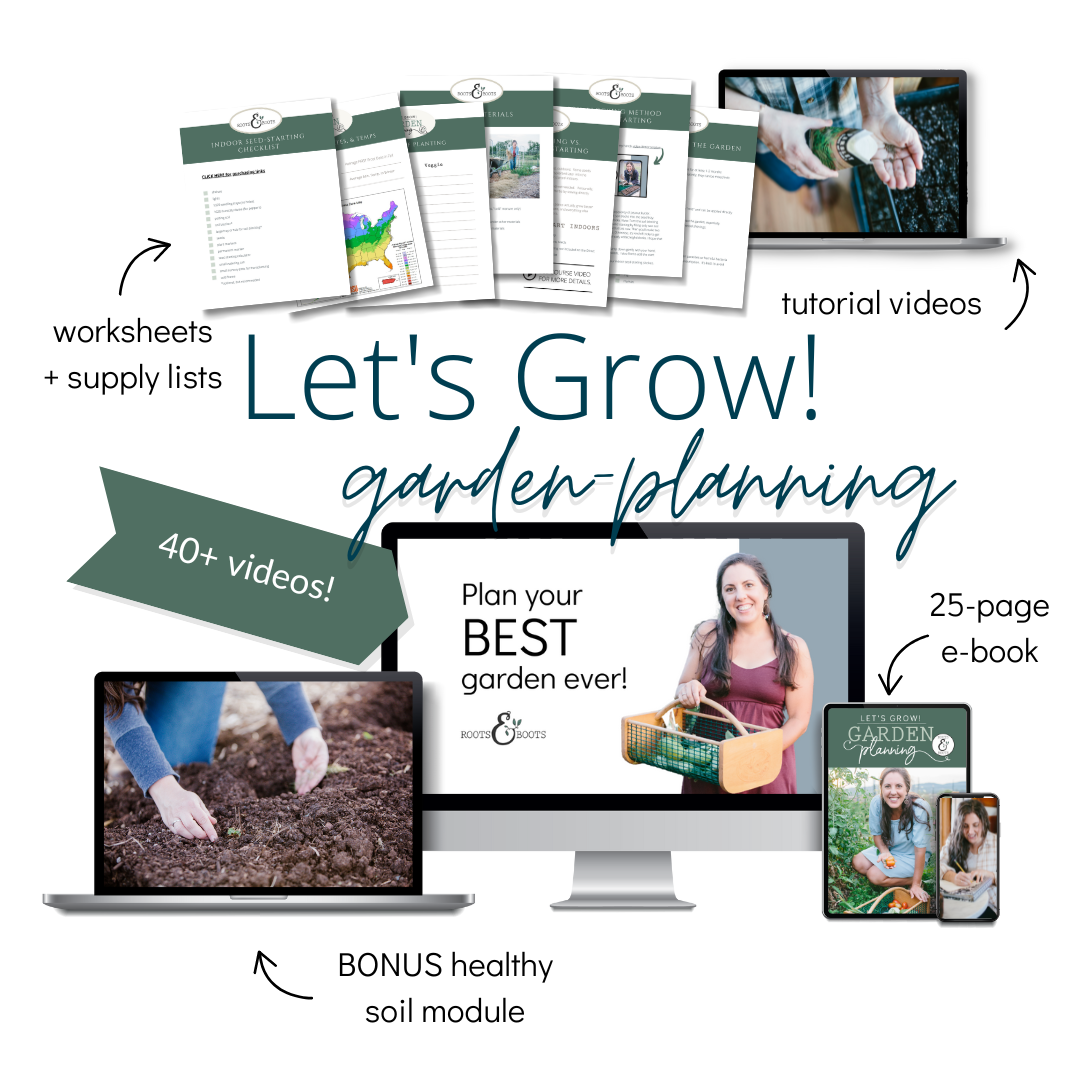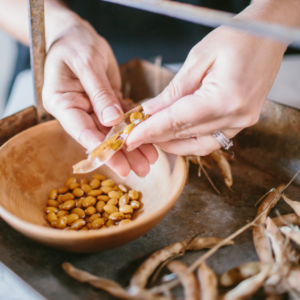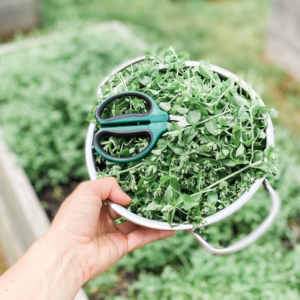How to Install Drip Irrigation in Raised Garden Beds

Plan your best garden with simple, step-by-step instructions!
This post may contain affiliate links, which means I make a small commission at no extra cost to you.
See my full disclosure here.
Wondering if it’s possible to install drip irrigation in your raised garden beds without the help of a professional? It is! If I can do it, I promise you can too.
And here’s the thing: drip irrigation is magical. It’s an absolute necessity for serious gardeners, food-growers, or anyone with a garden who ever wants to go on vacation!
Why install drip irrigation?
Installing drip irrigation will save you so much time throughout the growing season. Your plants will thrive thanks to consistent watering. What’s more, it will make it that much easier for a friend to water your garden while you’re away.
In addition to saving you tons of time, drip irrigation can help to prevent fungus and disease in your plants. Watering from above, especially in the evening, can lead to problems. Watering the soil via drip irrigation instead of watering the entire plant from above helps to keep the water where it belongs.

Our drip irrigation story
This year marks our fourth growing season on the farm, and I am so excited to report that we finally took the time to install drip irrigation in our kitchen garden. Hooray! I still have to hand water a few spots where we opted against drip lines, but having most of the garden hooked up to water at the flip of a switch is so dreamy.
I will admit that the process of installing drip irrigation felt super intimidating. From deciding on a kit to the actual installation, Greg and I tackled it together. It definitely felt like a two person job.
Once we got the hang of it, the process was actually pretty clear cut. I did make a big mistake about halfway through the installation. Of course we didn’t discover it until the very end, which meant we had to redo several steps. Ugh.
In the end, it took less than a full day to install drip irrigation in our entire raised bed kitchen garden. Yes, it was a lot of work. But the trade off was so worth it!
Want the video version? You can watch the entire process here (including my big mistake):
It’s already saved me SO much time. And it was a big help to our farm sitter during our family’s summer trip to the mountains. It gave me greater peace of mind to know that both of our large gardens would be well watered while we were away.
How to install drip irrigation: what you’ll need
To install drip irrigation in your own garden, here’s what you’ll need.
Remember: you can watch this process here.
- diverter
- pressure regulator
- 1/2-inch tubing
- T-connectors
- elbows
- shut off valves
- end caps
- hole punch
- 1/4-inch drip line
- drip line connectors (couplings)
- goof plugs
- landscape stakes
Get it all in this kit! (Stakes must be purchased separately.) You may need to customize the kit, depending on the size and configuration of your garden.
How to install drip irrigation in raised garden beds

Step one: water source
Parts needed:
- diverter
- pressure regulator
- 1/2-inch tubing
- scissors
The first step is to connect the 1/2-inch tubing to a water source. For us, that’s the pump in our kitchen garden.
The tubing connects via the included diverter. Between the diverter and the tubing, install the pressure regulator.
Note: in the video, you won’t see the pressure regulator. We didn’t realize we needed it until our water pressure blew out several 1/4-inch driplines. After that, we came back and installed the pressure regulator (the white piece marked “25 PSI”), like this:

It was so simple and it fixed the water pressure problem!
Step two: header line
Parts needed:
- T-connectors (depending on your configuration)
- end cap
- scissors
From the diverter and pressure regulator, run your 1/2-inch tubing to form a header line for your raised beds. Cut the tubing at the end of your garden and add an end cap.
If your garden contains more than one row of beds, you’ll need to run a secondary header line to each row. This part makes a lot more sense if you watch our video tutorial!

Step three: T-connectors
Parts needed:
- one T-connector per raised bed
- scissors
Next, where the header line meets the base of each bed, cut the line and insert a T-connector.

Step four: elbows
Parts needed:
- one elbow per raised bed
- 1/2-inch tubing, cut to length
- scissors
From the T-connector, run a length of 1/2-inch tubing up to the top of your raised bed. Cut the tubing and attach an elbow.

Step five: shut-off valve
Parts needed:
- one shut-off valve per raised bed
- 1/2-inch tubing, cut to length
- scissors
From the elbow, attach a small section of 1/2-inch tubing. Next, attach the shut-off valve and secure.

Step six: end cap
Parts needed:
- one end cap per raised bed
- 1/2-inch tubing, cut to length
- scissors
From the shut-off valve, run the 1/2-inch tubing to the end of the raised bed and attach an end cap.

Step seven: clamps
Parts needed:
- three C-clamps per raised bed
- hammer
Using a hammer, secure the 1/2-inch tubing to the raised bed with several C-clamps. We placed one clamp right below the elbow, right after the shut-off valve, and right before the end cap.

Step eight: drip line
Parts needed:
- 1/4-inch drip line
- drip line connectors
- goof plugs
- hole punch
- landscape stakes
Determine how many drip lines your raised bed will require and where they will be placed. Use the hole punch to make a hole in the 1/2-inch tubing where each drip line will connect.
Insert a drip line connector to the end of the drip line, then insert into the 1/2-inch tubing. Run the drip line to the end of your raised bed, then cut and add a goof plug.
Tips:
- You may need to use a needle nose pliers to insert the connectors and goof plugs. A strong husband is also helpful.
- I recommend using landscaping stakes to hold your drip line in place.
- If you use a kit, make sure to use DRIP LINE (with little holes) and not feeder line (no holes).
- For our 2-foot wide beds, we ran two drip lines. I now wish we’d installed three drip lines in each box.

Step nine: test the system
Before moving on to the rest of the beds or rows of beds, test the system to make sure it’s working properly. Turn on the water and watch what happens!
Step ten: repeat
Repeat steps three through nine for each additional bed.
And that’s it! Yes, it can be a tedious process. And the larger your garden, the more tedious it will be to install drip irrigation.
But believe me, it’s worth it! You’ll be so thankful you invested the time upfront to have a well-watered garden all season long.
More about gardening:
- How to Prune Basil for the Best Flavor
- How to Pinch Pepper Plants (& Why)
- DIY Wooden Raised Garden Beds
- How to Build Hugelkultur Raised Garden Beds

Sign up NOW for my best tips delivered weekly to your inbox!
You’ll also get instant access to my library of free ebooks and resources.








Great article. Only thing I would add is that if you are using a low pressure gravity fed system, it takes special drippers.
Thanks for this tip!
How long do you like the drip lane water run
Stumbled on this post while trying to figure out how to set up irrigation for my garden! The photos and written supply list here is SO great! I followed this to the letter and was able to get my irrigation set up in a few hours today. Only thing I would add- you need a 1/2″ poly to female hose thread adapter for where you connect the poly line to the low pressure piece and the diverter. Thank you for the help!
So happy to hear this, Maddie! Automated watering makes such a difference.